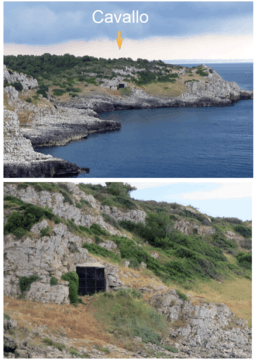Grotta del Cavallo
| Grotta del Cavallo | |
|---|---|
| Cavallo Cave | |
 | |
 | |
| Location | Apulia, Italy |
| Coordinates | 40°09′18″N 17°57′36″E / 40.155°N 17.96°ECoordinates: 40°09′18″N 17°57′36″E / 40.155°N 17.96°E |
| Geology | limestone |
The Grotta del Cavallo or Cavallo Cave (Italian:"Cave of the Horse") is a limestone cave in the region of Puglia, Southern Italy, near Nardò 90 kilometers south of Taranto. The cave is about 15 meters above present sea level. It has a rounded entrance, 5 metres (16.5 ft.) wide and 2.5 metres (8 ft.) high opening toward the sea. The cave was rediscovered in 1960 and two waves of excavations ensued. The first wave spanning from 1963 to 1966 and the second from 1986 to 2008. The cave was disturbed by looters during the period between the two waves of excavations, damaging the layers corresponding to the Upper Palaeolithic, because of this, the cave entrance is covered by a gate and is not open to the public.[1]
Archaeological Significance
The cave contains a rich stratigraphic succession of 7 metres (23 ft.) starting from an interglacial beach foundation. The most notable section of this sequence covers the Middle Palaeolithic, associated with the Mousterian culture and a subsequent strata, recently discovered to be associated with the earliest evidence of Anatomically Modern Humans in Europe known.
In 1964 two deciduous molars were discovered in the cave. Scientists described the teeth in 1967 as Neanderthal and assumed that the stone tools and shell bead ornaments excavated around them were associated with stone artefacts of a Neanderthal culture, later termed as Uluzzi[2][3] and closely associated with the Châtelperronian. However, association of the latter culture with Neanderthal people remains controversial.[4][5] In 2011, a team of researchers led by Stephano Benazzi of the Department of Anthropology at the University of Vienna published a study in the journal Nature which claimed that the two teeth were not from a Neanderthal specimen, but from an early Human and that these teeth date from 45,000 to 43,000 years before present and that this finding provided crucial evidence in supporting the claim that the Uluzzi were not a Neanderthal culture but an early Human one. [6] Although the Human provenance of these teeth are contended, no evidence contradicting this claim has been put forward [3][7] and has gained some acceptance. However, the attribution of the entire Uluzzi technology to Anatomically Modern European Humans is more contentious.[8]
References
- ↑ Benazzi, S., Katerina Douka, Cinzia Fornai, Catherine C. Bauer, Ottmar Kullmer, Jiří Svoboda, Ildikó Pap, Francesco Mallegni, Priscilla Bayle, Michael Coquerelle, Silvana Condemi, Annamaria Ronchitelli, Katerina Harvati & Gerhard W. Weber "Grotta del Cavallo: Description of the site and history of excavations." Nature: Supplementary Information, Nature Publishing Group, 02 Nov. 2011, retrieved 12 Nov. 2015
- ↑ Marta Camps. Sourcebook of Paleolithic Transitions. Methods, Theories, and Interpretations. Springer, 2009: 385.
- 1 2 Callaway, Ewen. "Who were Europe’s first humans?", Nature blog, Nature Publishing Group, 02 Nov. 2011, retrieved 12 Nov. 2015
- ↑ Higham T, Jacobi R, Julien M, David F, Basell L, Wood R, Davies W, Ramsey CB.C (2010). Chronology of the Grotte du Renne (France) and implications for the context of ornaments and human remains within the Chatelperronian. Proc Natl Acad Sci U S A. doi:10.1073/pnas.1007963107 PMID 20956292
- ↑ Mellars P. (2010). Neanderthal symbolism and ornament manufacture: The bursting of a bubble? Proc Natl Acad Sci U S A. doi:10.1073/pnas.1014588107
- ↑ Benazzi, S., Katerina Douka, Cinzia Fornai, Catherine C. Bauer, Ottmar Kullmer, Jiří Svoboda, Ildikó Pap, Francesco Mallegni, Priscilla Bayle, Michael Coquerelle, Silvana Condemi, Annamaria Ronchitelli, Katerina Harvati & Gerhard W. Weber "Early dispersal of modern humans in Europe and implications for Neanderthal behaviour" Nature, V.479, pp. 525–528 Nature Publishing Group, 02 Nov. 2011, retrieved 12 Nov. 2015
- ↑ Zilhão, Joã, William E. Banks, Francesco d’Errico, and Patrizia Gioia, (2015) PHILOSOPHICAL (AND OTHER) TRANSACTIONS ON THE GROTTA DEL CAVALLO, THE SCIENCE OF ARCHEOLOGY, AND THE ETHICS OF PUBLICATION, "Researchgate"
- ↑ Zilhão, Joã, William E. Banks, Francesco d’Errico, and Patrizia Gioia, "Analysis of Site Formation and Assemblage Integrity Does Not Support Attribution of the Uluzzian to Modern Humans at Grotta del Cavallo", PLoS ONE, 10(7): e0131181. doi:10.1371/journal.pone.0131181